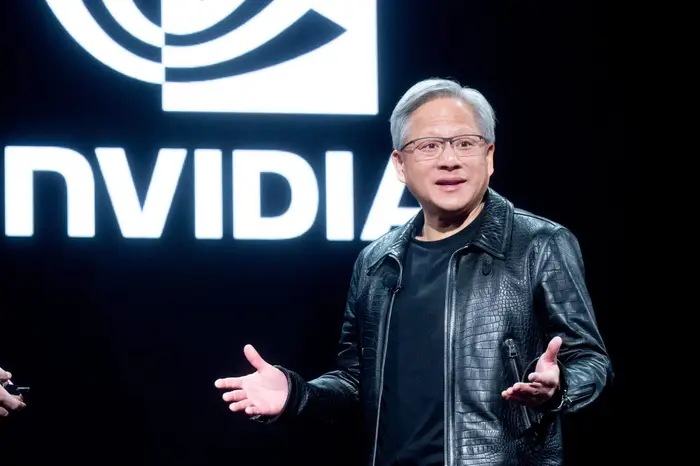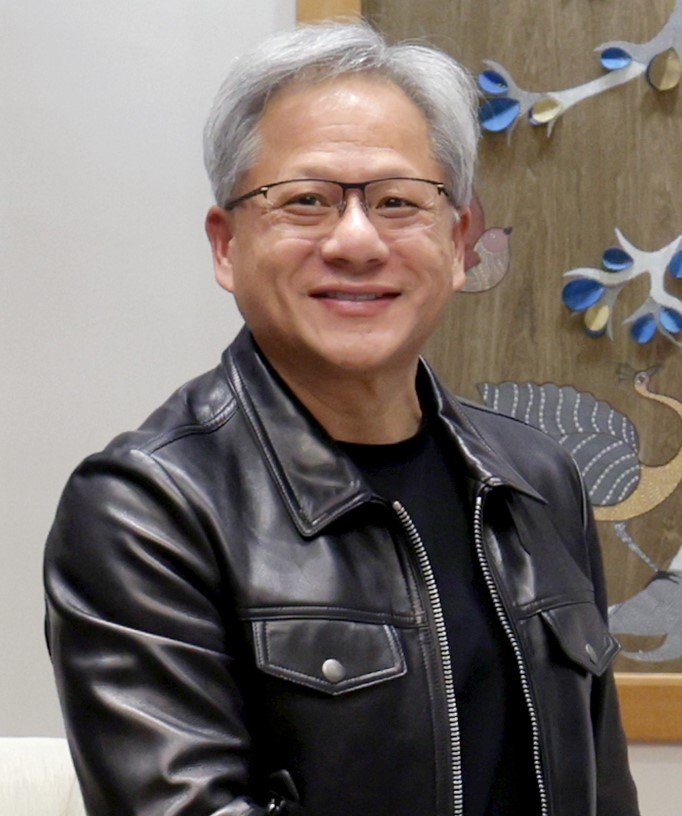Jen-Hsun “Jensen” Huang Then and Now
Jen-Hsun “Jensen” Huang Then
Jen-Hsun “Jensen” Huang, born on February 17, 1963, in Tainan City, Taiwan, is a renowned figure in the technology industry, particularly as the co-founder and CEO of NVIDIA.
His journey from Taiwan to the United States at the age of nine set the stage for his future accomplishments.
Initially settling with his family in Oneida, Kentucky, Huang attended the Oneida Baptist Institute, a boarding school where he began adapting to life in the U.S.
The family later moved to Oregon, where Huang completed his high school education at Aloha High School in Portland’s suburbs.
After graduating high school, Huang pursued his passion for technology and engineering at Oregon State University in Corvallis. There, he earned a degree in electrical engineering in 1984.
His academic journey did not stop there—he furthered his education by enrolling in a master’s program in electrical engineering at Stanford University, one of the world’s leading institutions for technology and innovation.

He completed his master’s degree in 1992, a pivotal moment that prepared him for his remarkable career ahead.
Huang’s technical expertise and vision were instrumental in the founding of NVIDIA in 1993.
Under his leadership, NVIDIA became a trailblazer in the field of graphics processing units (GPUs), revolutionizing industries such as gaming, artificial intelligence, and autonomous vehicles.
Huang’s educational foundation, built on his experiences in both Oregon State and Stanford, equipped him with the skills and knowledge to drive innovation in computing and establish NVIDIA as a global leader in the technology sector.
Related Article: David Baszucki Then and Now
Jen-Hsun “Jensen” Huang Career
After earning his master’s degree in electrical engineering from Stanford in 1992, Jensen Huang embarked on a promising career in the semiconductor industry, which laid the groundwork for his later accomplishments.
His first major role was as a director at LSI Logic Corporation, a prominent company based in Santa Clara that specialized in designing and manufacturing custom chips.
LSI Logic was known for providing cutting-edge semiconductor technology, and Huang’s position as director gave him valuable experience in managing and leading complex engineering projects.
During his time there, Huang honed his skills in semiconductor technology and design, learning the intricacies of chip architecture and system integration.
Related Article: Marc Benioff Then and Now
In addition to his role at LSI Logic, Huang also worked as a microprocessor designer at Advanced Micro Devices (AMD), another key player in the semiconductor industry.
AMD, headquartered in Santa Clara, focused on developing high-performance microprocessors and graphics technologies.
Huang’s experience at AMD exposed him to the world of microprocessor design, further refining his expertise in the architecture and functionality of processing units.
His hands-on work with microprocessors at AMD provided him with a deep understanding of the computational power needed for various applications, ranging from personal computing to enterprise systems.
Related Article: Brian Chesky Then and Now
These early career roles were instrumental in shaping Huang’s technical knowledge and leadership abilities, which would later become pivotal when he co-founded NVIDIA in 1993.
His experiences at both LSI Logic and AMD gave him a comprehensive understanding of the semiconductor industry, allowing him to anticipate emerging trends in technology and computing.
This foresight led to NVIDIA’s development of graphics processing units (GPUs), which transformed industries like gaming, artificial intelligence, and scientific computing, positioning Huang as a visionary leader in the tech world.
Related Article: Dara Khosrowshahi Then and Now

Nvidia Corporation
In 1993, Jensen Huang, alongside Chris Malachowsky and Curtis Priem, co-founded NVIDIA with a vision to revolutionize computing through advanced graphics technology.
The trio, all seasoned engineers with backgrounds at prominent tech companies, recognized that the future of computing would be heavily influenced by graphics and visual experiences.
They believed that video games would drive this next wave of innovation, leading them to develop cutting-edge graphics processing units (GPUs) that could enhance visual rendering in real time.
This forward-thinking approach positioned NVIDIA at the forefront of the emerging graphics industry.
Related Article: Travis Kalanick Then and Now
NVIDIA quickly solidified its reputation as a leader in graphics technology with the release of the RIVA TNT in 1998, a groundbreaking graphics accelerator chip for personal computers.
This product not only improved the quality of graphics for PC users but also demonstrated NVIDIA’s commitment to pushing the boundaries of graphical performance.
The following year marked a significant milestone with the launch of the GeForce 256, which was a game-changer in the industry.
It introduced onboard transformation and lighting capabilities to consumer-grade 3D hardware, setting new standards for visual fidelity in video games and other applications.
Related Article: Daniel Ek Then and Now
This innovation not only captured the attention of gamers but also propelled NVIDIA’s stock market debut, further establishing the company’s influence in the tech world.
As NVIDIA entered the new millennium, it embarked on a series of strategic acquisitions to enhance its technological capabilities and broaden its product offerings.
The company acquired notable firms such as 3dfx, Exluna, MediaQ, and Ageia, which allowed NVIDIA to integrate advanced technologies and talent into its operations.
This expansion was crucial for NVIDIA, as it not only solidified its dominance in the graphics market but also enabled the company to diversify into other sectors, such as engineering, architecture, and scientific research, through its professional line of GPUs.
Related Article: Evan Spiegel Then and Now
NVIDIA’s innovative spirit led to the development of the CUDA (Compute Unified Device Architecture) platform, an API that facilitates the creation of massively parallel programs leveraging GPUs for high-performance computing.
This technology is utilized in supercomputing environments around the globe, showcasing NVIDIA’s influence in both the gaming industry and scientific research.
As the company expanded, it also ventured into mobile computing, developing products like vehicle navigation systems and processors for smartphones and tablets.
Additionally, NVIDIA has strengthened its presence in the gaming sector with handheld consoles, such as the Shield Portable, and cloud gaming services like GeForce Now.
Related Article: Reed Hastings Then and Now
In recent years, NVIDIA has emerged as a leader in artificial intelligence (AI), leveraging its powerful GPUs to support deep learning and machine learning applications across various industries.
This strategic pivot has not only diversified NVIDIA’s portfolio but also positioned the company as a key player in the rapidly evolving tech landscape.
Through continuous innovation and strategic foresight, Jensen Huang and NVIDIA have significantly shaped the future of computing, reinforcing their legacy as pioneers in graphics and AI technology.
Related Article: Sheryl Sandberg Then and Now
Jen-Hsun “Jensen” Huang’s Wife and Children
Jensen Huang is married to Lori, a partnership that began in their college years when they met as engineering lab partners at Oregon State University, and together they have raised two children, balancing their family life with Huang’s demanding career as a leader in the technology industry.
Related Article: Tim Cook Then and Now
Jen-Hsun “Jensen” Huang Now

As of now, Jen-Hsun “Jensen” Huang is 61 years old and continues to be a prominent figure in the technology industry.
As the founder, president, and chief executive officer (CEO) of NVIDIA, he has played a crucial role in shaping the company’s vision and driving its growth since its inception in 1993.
Under Huang’s leadership, NVIDIA has evolved from a startup focused on graphics processing units (GPUs) to a powerhouse in artificial intelligence, gaming, and high-performance computing.
Related Article: Susan Wojcicki Then and Now
His commitment to innovation and excellence has established NVIDIA as a leader in the semiconductor industry, with a significant impact on various sectors, including gaming, automotive technology, and data science.
In addition to his professional achievements, Huang is also known for his philanthropic efforts.
He has been involved in initiatives that support education, research, and technological advancement, reflecting his belief in the importance of giving back to the community.
His contributions extend beyond the corporate world, as he actively participates in discussions about the future of technology and its implications for society.
Related Article: Bill Gates Then and Now
Huang’s vision for NVIDIA encompasses not just business success, but also the role of technology in enhancing human experiences and addressing global challenges.
As he navigates the ever-evolving landscape of technology, Jensen Huang remains a key influencer and innovator, inspiring the next generation of engineers and entrepreneurs.
His legacy is marked by a commitment to pushing the boundaries of what’s possible, making him a respected figure in both the tech community and beyond.
Related Article: Mark Zuckerberg Then and Now
Jen-Hsun “Jensen” Huang Net Worth
Jen-Hsun “Jensen” Huang, a Taiwanese-American billionaire business magnate and electrical engineer, boasts an impressive net worth of $108.4 billion, a testament to his success as the co-founder and CEO of NVIDIA, where his visionary leadership has driven the company’s remarkable growth and innovation in the technology sector, particularly in graphics processing and artificial intelligence.
Related Article: Satya Nadella Then and Now
FAQs
Jensen Huang has a net worth of approximately $108.4 billion, making him one of the wealthiest individuals in the tech industry.
Huang’s annual compensation varies but includes a salary, bonuses, and stock options. In recent years, his total annual compensation has been reported to be in the tens of millions, often exceeding $20 million when including stock awards.
Huang is extremely wealthy, with a net worth placing him among the top billionaires globally, largely due to the success of NVIDIA and the skyrocketing value of its stock.
Yes, Huang has sold over $24 million worth of NVIDIA stock in various transactions, which is a common practice among executives to diversify their holdings and realize gains.
Jensen Huang resides in the San Francisco Bay Area, California, a hub for technology and innovation.
The current CEO of NVIDIA is Jen-Hsun “Jensen” Huang, who has held this position since the company’s founding in 1993.






























